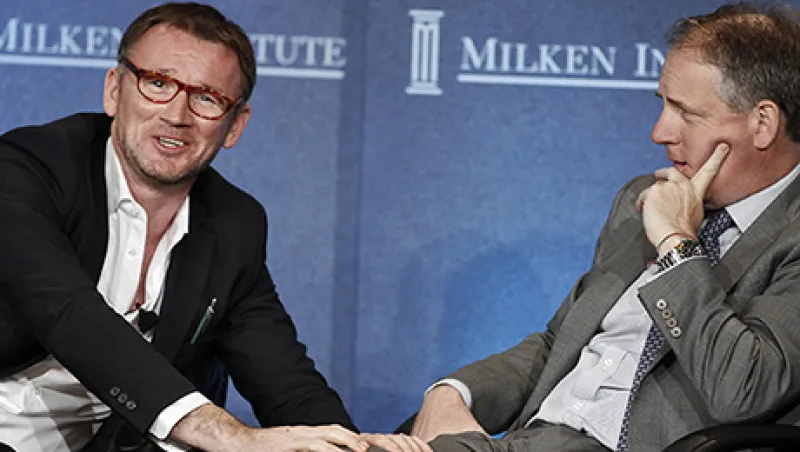Late in 2013, Hugh Hendry, CIO and founding partner of Eclectica Asset Management, recanted on his investment sins. In a letter to clients, Hendry repudiated his past bearishness on equities, an approach that had yielded a return of precisely zero for the London-based global macro hedge fund firm’s flagship Eclectica Fund that year.
Hendry has been rewarded for his about-face. In 2014 the Eclectica Fund gained 9.5 percent after fees, versus only 5.6 percent for the HFRI Macro index published by Chicago-based Hedge Fund Research. In the first half of this year, it delivered 9.9 percent, compared with just 2 percent for the HFRI Macro index.
Hendry set up the winning position in August 2014. “We concluded that policymakers were willing to see the [U.S.] dollar rise, so the share of marginal GDP growth would swing in favor of the rest of the world,” he tells Institutional Investor. As a result, Eclectica went long the greenback, U.S. Treasuries and non-U.S. equities.
Today his most striking contrarian view is sunny optimism about Chinese equities. Speaking a few days after the monthlong rout in mainland stocks had ended, he argued that the market would resume its ascent because of rising Chinese wages, growing household consumption and effective government policy to solve the country’s debt problems. The firm has reduced its combined triple-play position, but not eliminated it.
Eclectica is enjoying a hot streak, but the fund — like many discretionary macro vehicles — has seen plenty of ups and downs. Jersey-based Brevan Howard Asset Management, whose $27 billion in assets make it one of the world’s largest macro hedge fund firms, reported a loss for its main fund in 2014 — the first since its inception in 2003. At Tudor Investment Corp., the Greenwich, Connecticut–based hedge fund firm founded by Paul Tudor Jones II, the flagship Tudor BVI Global Fund returned just 3 percent in 2014, far below the double-digit increases of many previous years.
The Eclectica Fund was launched in 2002 by London-based Odey Asset Management, with Hendry as portfolio manager. He left three years later, taking the fund with him, to set up his own shop. Since 2005 the fund has made several successful bets based on unconventional views. In 2007, for example, it wagered that the gap between two- and ten-year U.S. Treasury yields would rise — a prediction that returned 31 percent in 2008 as the U.S. Federal Reserve Board slashed short-term rates in response to the financial crisis.
At other times, however, performance has underwhelmed. In 2006 the Eclectica Fund lost 3.7 percent, in 2009 it dropped 8 percent, and in 2012 and 2013 it lost money or tread water. “We’re like a volcano,” Hendry says. “We have periods when we capture changes in long-term trends and make a great deal of money. It then takes six months to two and a half years for markets to align again with our views.”
Assets under management have risen and fallen accordingly. Eclectica manages about $280 million; of that total, $90 million is in the Eclectica Fund, $60 million in an offshore managed account that mirrors the fund, and $55 million in a U.K. retail mutual fund that mimics the Eclectica Fund. The firm has an additional $40 million in an agriculture fund and $35 million in a European equity long-only managed account. Assets are higher than the $247 million total at the end of 2014 but far below a 2012 peak of $1.2 billion.
In recent years Eclectica’s investor base has expanded beyond wealthy individuals to include institutions. Given its strong recent and long-term performance — the Eclectica Fund has achieved a 9 percent compound annual return since 2002 — why hasn’t the firm attracted more money? “People are very conservative,” Hendry says. “They would rather fail in a conventional manner than succeed in an unconventional manner, so we are never destined to be a big, bulge-bracket asset manager.”
Other global macro funds have faced an even sterner struggle to draw investors because they’ve failed to match Eclectica’s recent success. The HFRI Macro index suffered negative returns in 2011, 2012 and 2013. After a modest gain in 2014, it edged down by 0.4 percent in the first half of this year. And some funds have stumbled badly. The Odey European Fund run by Hendry’s old boss, Crispin Odey, lost nearly 20 percent in April alone when he was caught out by a rally in European stocks and the Australian dollar.
Many macro funds owe their dull performance of late to the becalming effect of monetary easing, contends Akshay Krishnan, head of macro strategies at London-based Stenham Asset Management, a fund-of-hedge-funds manager with $3.3 billion under management. “Global macro is a cyclical strategy that can struggle when volatility is low,” he says. Macro managers tend to benefit from periods of disruption like the 2008 financial crisis, which served Eclectica well. Krishnan thinks such a spell could come soon as markets start to focus on a potential rate hike by the Fed.
Diane Miller, a London-based principal with consulting firm Mercer, defends global macro on the basis of risk and return. She points to the Credit Suisse Global Macro Hedge Fund index, which posted an annualized return of 8.2 percent above cash from 1994 to 2014, compared with only 6.7 percent for the S&P 500 index. “When you look at the return you’re getting for the risk you’re taking, global macro is pretty competitive,” Miller says.
Get more on hedge funds and alternatives.






